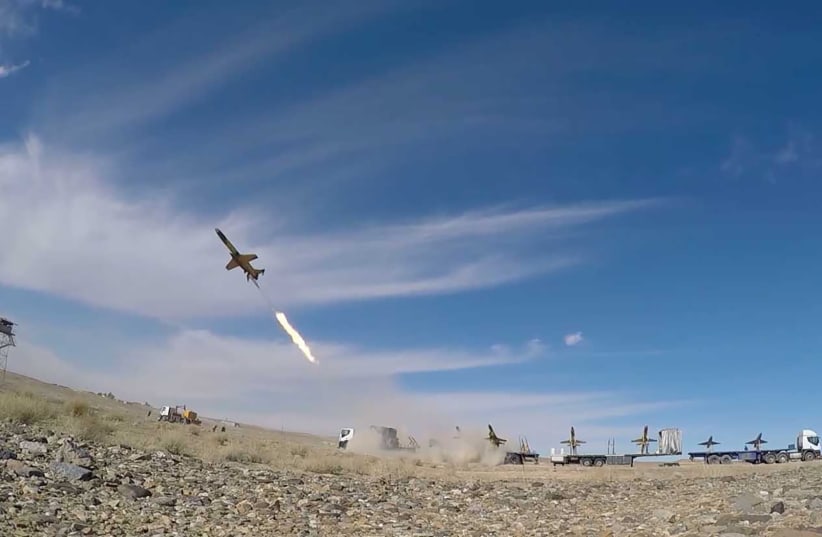The US-led coalition that is continuing efforts against ISIS has faced new challenges in Iraq and Syria in recent months. Among these are continuing drone and rocket attacks likely carried out by pro-Iranian militias. In early July, the attacks were taking place several times a week and had expanded to include threats to US forces in Syria.
US-led coalition spokesperson Wayne Marotto discussed the challenges with The Jerusalem Post by correspondence. He emphasizes that the coalition – officially called the Combined Joint Task Force-Operation Inherent Resolve – is in Iraq at the invitation of the Iraqi government.
“The mission of CJTF-OIR is to defeat Daesh [ISIS] in designated areas of Iraq and Syria in conjunction with our partner forces (the ISF [Iraqi Security Forces], Peshmerga and SDF [Syrian Democratic Forces]) and to set conditions for follow-on operations to increase regional stability,” Marotto said.
In 2020, the US and its partners consolidated the facilities they use in Iraq. This occurred as rocket fire increased. Facilities at Taji, Q-West south of Mosul and K-1 near Kirkuk were handed to Iraqi security forces; US forces are now located only in a few places, such as Asad base, Union III in Baghdad near the embassy and at Erbil International Airport. Beyond that, there are some contractors at Balad airbase.
“The relatively small number of US forces that remain in Iraq advise, equip and assist Iraqi forces, who now lead the fight against Daesh [ISIS],” Marotto points out. “The mission of the coalition remains – defeat Daesh and its remnants in designated portions of Iraq and Syria.
“A year ago, there were over 5,000 US troops in Iraq. Today there are 2,500,” he said. “The drawdown has not affected the mission, because the ISF has taken the lead in the fight against Daesh.”
IN RECENT months, rocket and drone attacks have increased.
“We remain concerned about the actions of outlaw militia groups – and the recent attacks are a significant distraction from the defeat-Daesh mission. All capabilities in theater remain flexible to support increased force protection of coalition troops as necessary, based on threat streams,” says Marotto. These groups are accused of training regional proxies to attack the US while it is working with the coalition to fight ISIS.
“Ensuring the safety of coalition personnel is the highest priority for Lt.-Gen. Paul Calvert, commanding general, CJTF-OIR,” he said. “We regularly review and evaluate the safety, security and operations of the Iraqi facilities where the coalition is colocated.” The coalition can’t elaborate further on its method of force protection.
“Each attack against the government of Iraq, Kurdistan Region of Iraq and the coalition undermines the authority of Iraqi institutions, the rule of law and Iraqi National sovereignty,” says Marotto. The US and coalition forces have said they have the right to defend themselves.
“The coalition will take necessary and appropriate measures to defend US/coalition personnel and our partner forces in the region,” he said.
The coalition does not discuss the recent airstrikes carried out against these “outlaw militia groups” in Syria. Two rounds of airstrikes have been reported so far in response to attacks in February and June.
Recent threats have included increased use of drones by the pro-Iranian militias. Some of these drones have been displayed in parades. The head of Central Command, Gen. Frank McKenzie has warned about the increasing role of small drones being used as threats in the region.
“Coalition air defense systems, C-RAM [Counter rocket, artillery and mortar], Patriot batteries and our other radars are good at seeing the larger objects,” Marotto said. “The smaller drone is a problem. But the US Department of Defense is implementing a variety of means to counter the UAS [unmanned aircraft systems].”
Of particular interest, he notes that the US Marines have a new type of weapon to defend against drone threats. “The Dronebuster is a hand-held jammer that can force a UAS to descend or to return to its operator. If a drone is positively identified, a Marine standing on post can point the device at the drone and eliminate it as a threat.” Another system, dubbed CLaWS (Compact Laser Weapon System), “gives the coalition a dynamic defense against attack drones.”
ANOTHER KEY objective of the coalition in Iraq and Syria lies in the fight against ISIS. The worldwide jihadist organization once controlled 110,000 sq. km. and ruled eight million people, but today is “territorially defeated.”
However, Marotto stressed that today, “Daesh remains a capable and dangerous threat. It remains intent on regrouping and carrying out attacks.” This includes recent attacks on electricity pylons, including against 44 or 45 electricity towers last week.
In response, the coalition and Iraq’s partnership is key to continue the fight against ISIS through a variety of security objectives, including working together on “counterterrorism, biosecurity, border security and defense institution building.” At the same time, the Iraqi Security Forces have “moved into the lead” of the fight as the coalition moves to a support role, including training, advising, intelligence and surveillance – but a drawdown of forces in direct combat.
In addition, according to Marotto, Operation Inherent Resolve, the US military’s operational name for international military intervention against ISIS, has trained over 220,000 Iraqi security personnel since 2014. The training facilities are today under full control of the government of Iraq for the ISF to train themselves.
In Syria, the fight against ISIS includes working with partner forces, including the SDF under UN Security Council Resolution 2254. Marotto “thank[ed] the SDF for their sacrifices” and stressed that in Syria, “there is no truth to the disinformation that the US is stealing oil or wheat in northeast Syria.”
